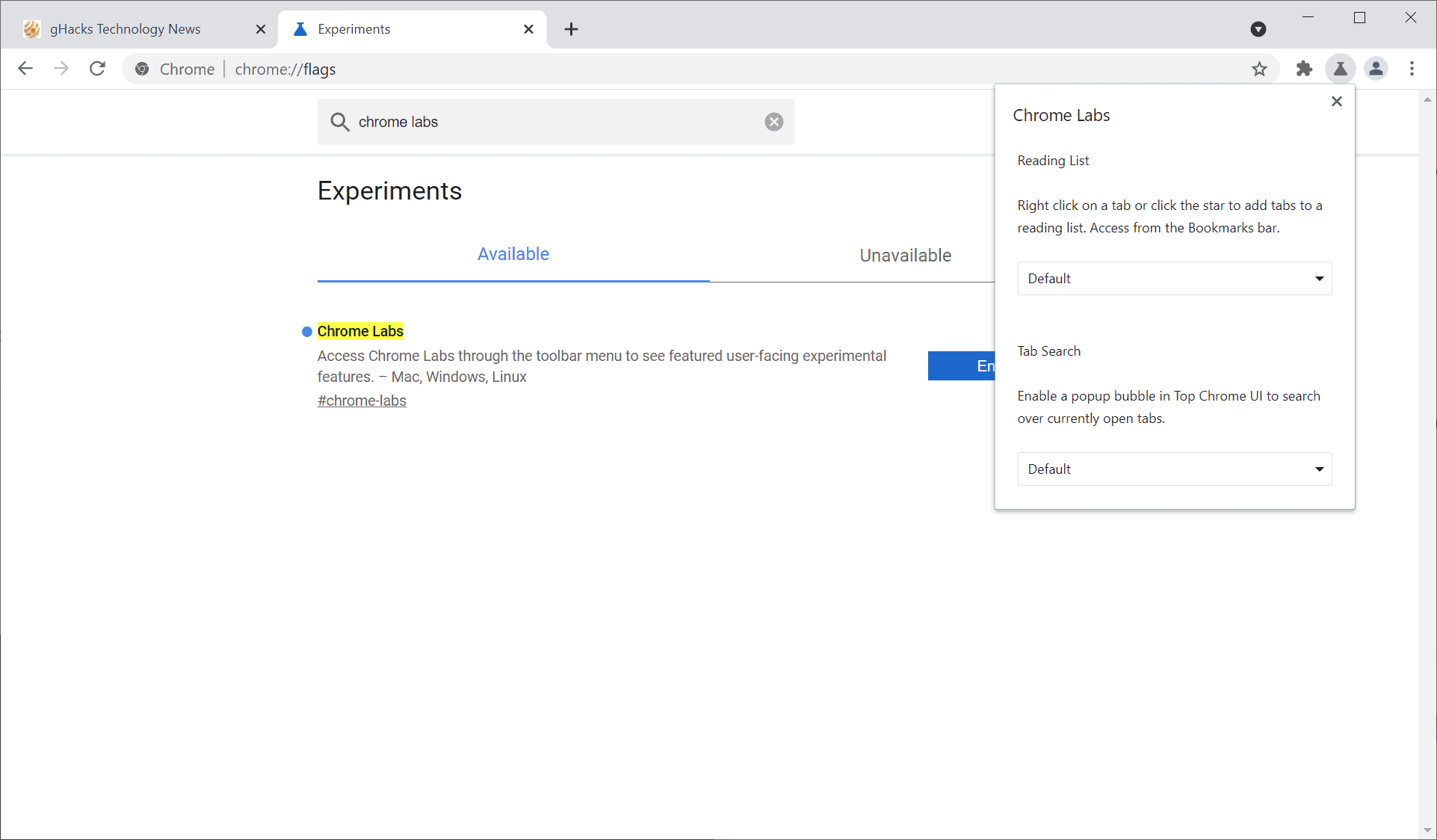Google tests Chrome Labs feature in Chrome to promote experimental browser features

Google is running an experiment currently in the company's Chrome web browser to promote certain experimental features to users of the browser. Experienced users know that they may activate experiments on the chrome://flags page; problem is, there are a lot of them and it is quite difficult to keep an overview and stay up to date with recent additions or changes.
The Chrome Labs test attempts to highlight some of the experiments to the user directly. The feature is only available in Chrome Canary builds at the time of writing and needs to be enabled before it becomes available.
Here is how that is done:
- Make sure that Chrome Canary is up to date. You can check the version and run a check for updates on this internal page: chrome://settings/help. Our tested version was 89.0.4353.0.
- Load chrome://flags/ in the browser's address bar.
- Type Chrome Labs in the search field.
- Set The Chrome Labs experiment flag to Enabled.
- Restart Google Chrome.
You will see a new icon that looks like a test tube in the browser's main toolbar after the restart. Activate it with a click or tap, and you will get the list of experiments that are available via Chrome Labs currently.
Two experiments are listed currently:
- Reading List -- New option to add tabs to a reading list by right-clicking on the tab or clicking on the bookmark star and selecting "add to reading list". The bookmarks bar displays a new reading list folder that you may select to display all pages that you added to the reading list. You may set these pages to read to remove them again from the reading list.
- Tab Search -- Adds a new tab search icon to Chrome's tab bar that you may use to search across all open tabs.
A restart is required to enable the selected features in the Chrome browser.
The experiments may also be enabled on chrome://flags.
Google is not the only browser maker that started to improve the discoverability of experimental features. Mozilla and Vivaldi have added similar pages to the browsers they develop to improve the discoverability of experimental features.
Closing Words
It does not seem likely that Google is going to add the Chrome Labs page to the toolbar of all Chrome installations. Maybe, it will become an option in Settings to enable it, or Google will follow others by adding these promoted experiments to the Settings directly.
Now You: what is your take on this?




















That should appeal to the lab rats.
The https://www.ghacks.net/2020/11/18/chrome-87-launches-with-tab-search-performance-improvements-and-new-chrome-actions-feature/ ‘New tab search icon’ is already functional for me using Version 88.0.4324.41 (Official Build) beta (64-bit) of Chrome, and it woks nicely.
Well, it’s the same crap like Firefox Experiments / Normandy, just for Chrome. Final versions of web browsers should contain NO temporary or experimental features. Especially troublesome is the fact that these browser vendors can more or less remotely install and run arbitrary code, without having to use the regular update functionality of the browser, of which the user is typically aware. That ability has lead to scandals like this:
https://www.zdnet.com/article/firefox-tests-cliqz-engine-which-slurps-user-browsing-data/
I am strongly opposed to any such anti-feature, and I think of it as a security hole that should be plugged, either by disabling experiments or by using another browser altogether. As far as this article is concerned, another reason to avoid Chrome if possible.
The ability to remotely download and run arbitrary code without the user consent used to be part of the definition of what a “trojan” is, by the way.
Waterfox is a Firefox variant which has this type of stuff disabled, the same is true for Ungoogled Chromium / Brave / Bromite as variants of Chromium
I have a strong antipathy to Google’s business model and ethical practices, and I accordingly removed Chrome from my home and work PCs about two years ago. It felt good to see it disappear. Nonetheless, I can’t see why you are bothered by a ‘feature’ that has to be deliberately turned on by a user to be operational. People who want it (and in this case, anyway, Google has implemented this in a way that ensure that only reasonably sophisticated users will even know the option is available) can use it; those who feel like you can simply ignore it.
Re: user consent. By electing to participate in these experiments, the users are explicitly giving Google consent to do things (even if what those things are is certainly not always clear). There is of course very many areas where Google does whatever the hell it wants without getting user consent, but this does not strike me as one of them.